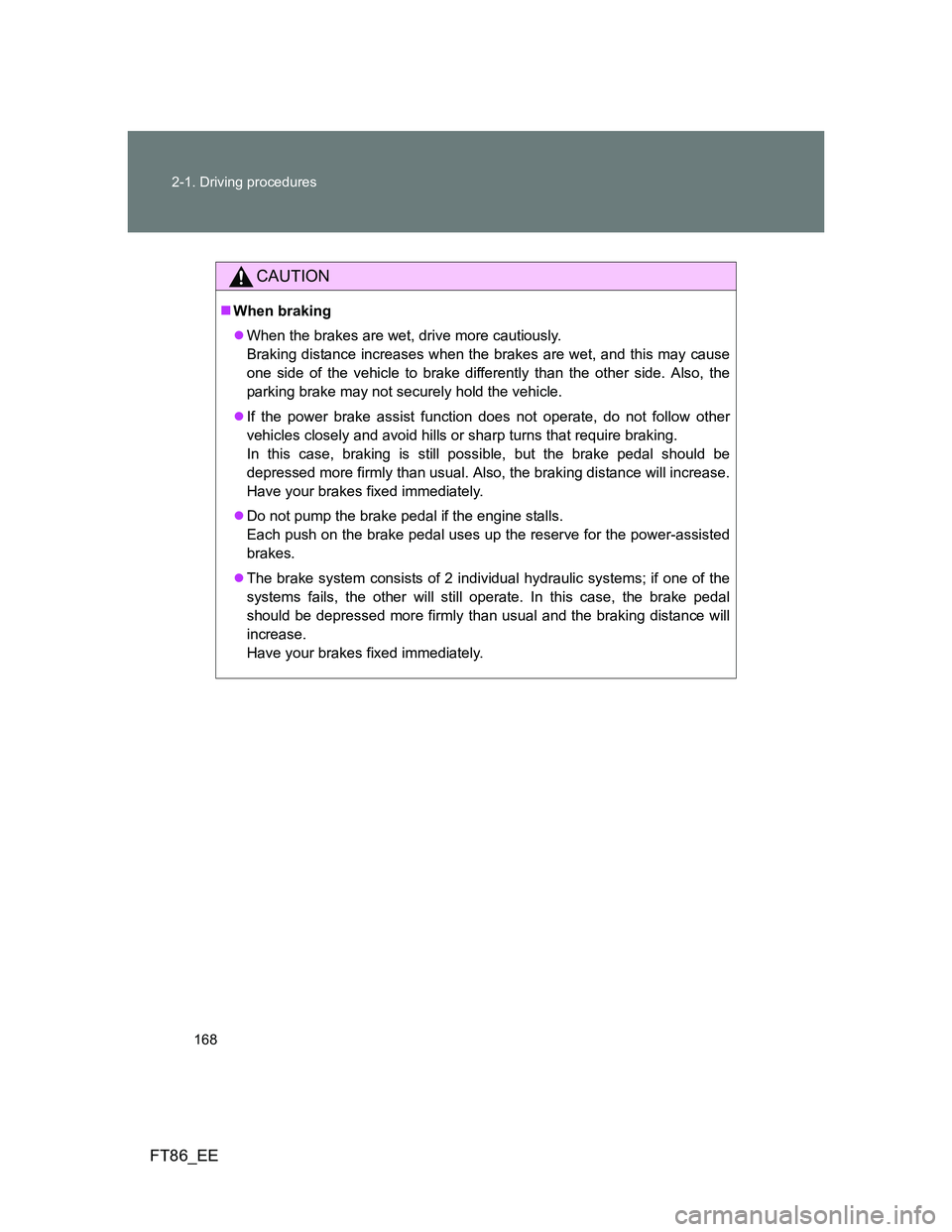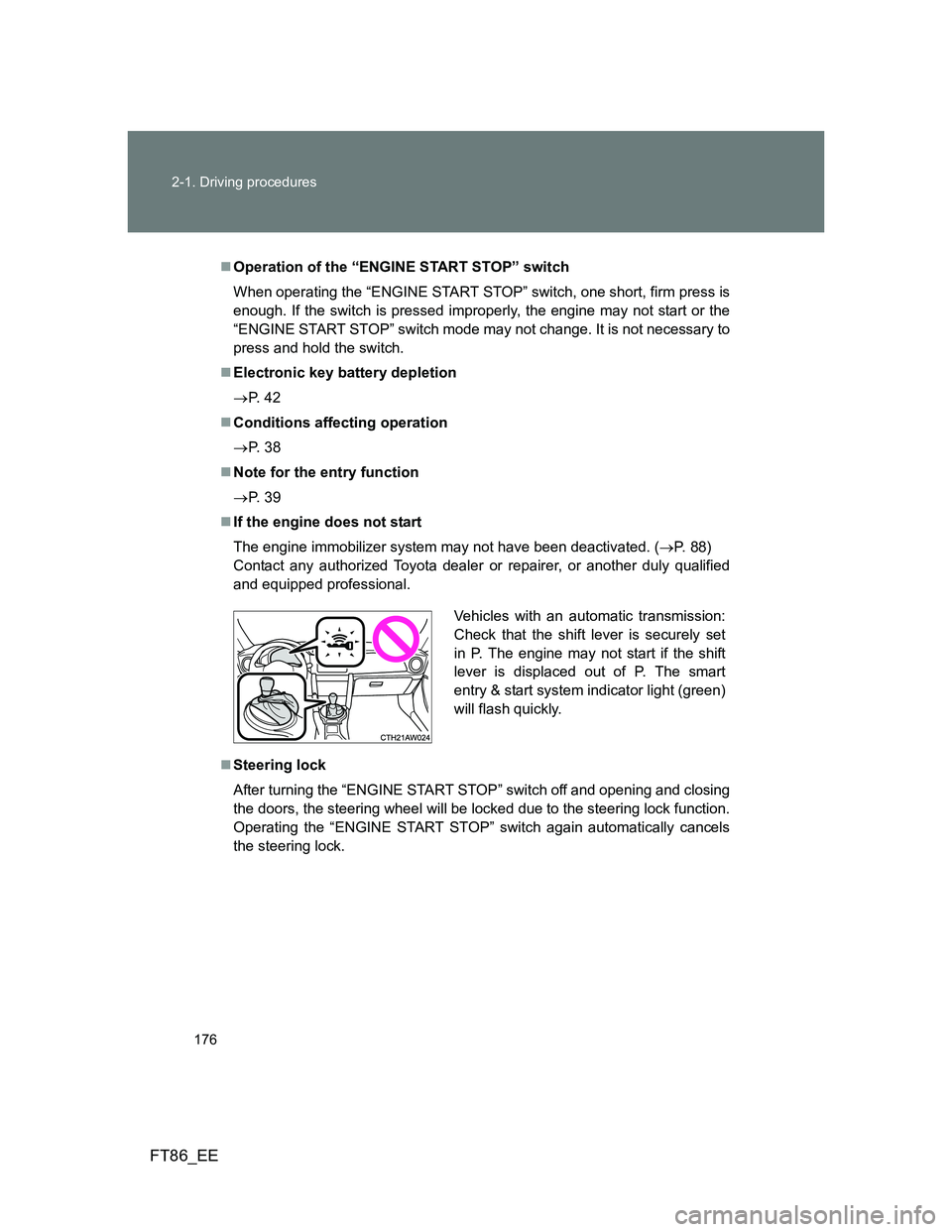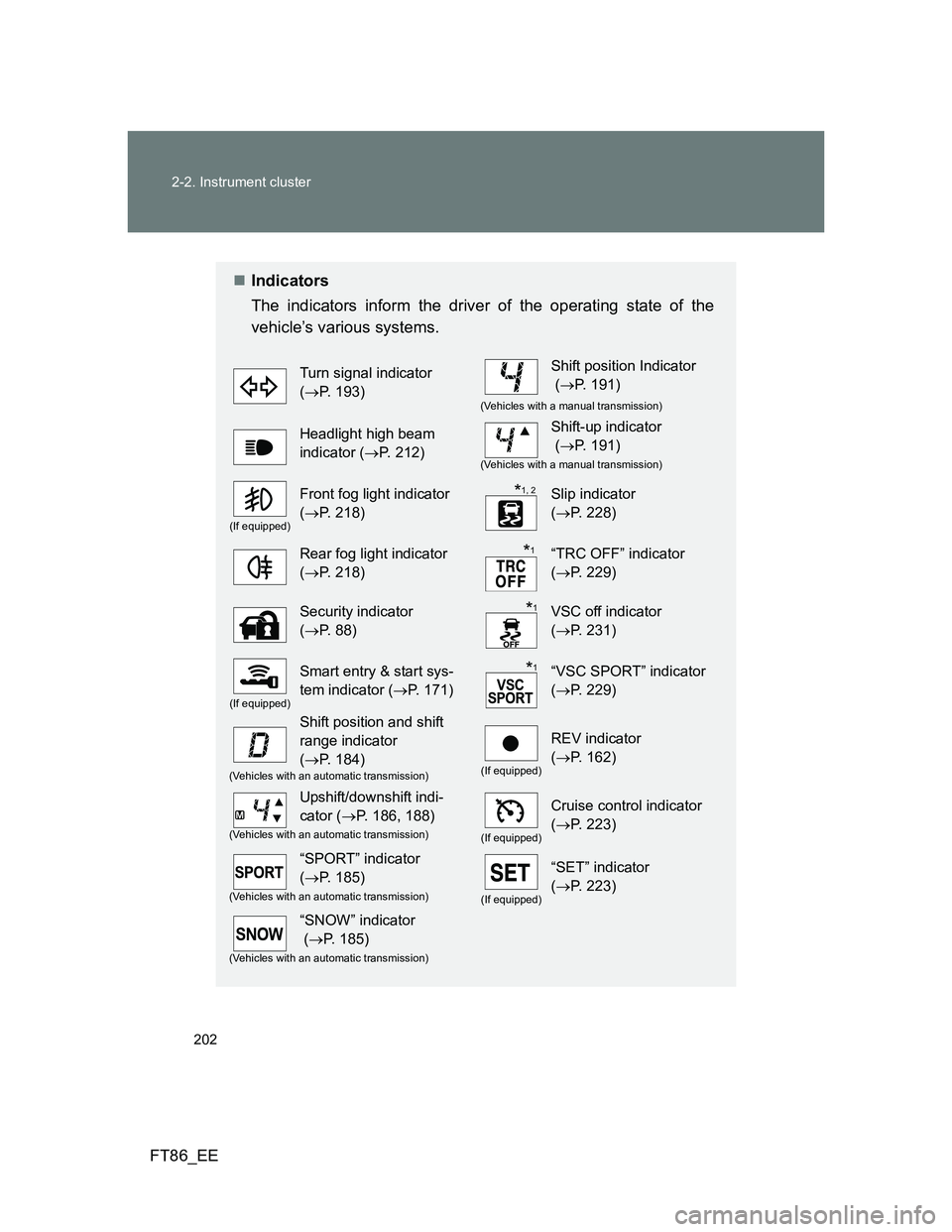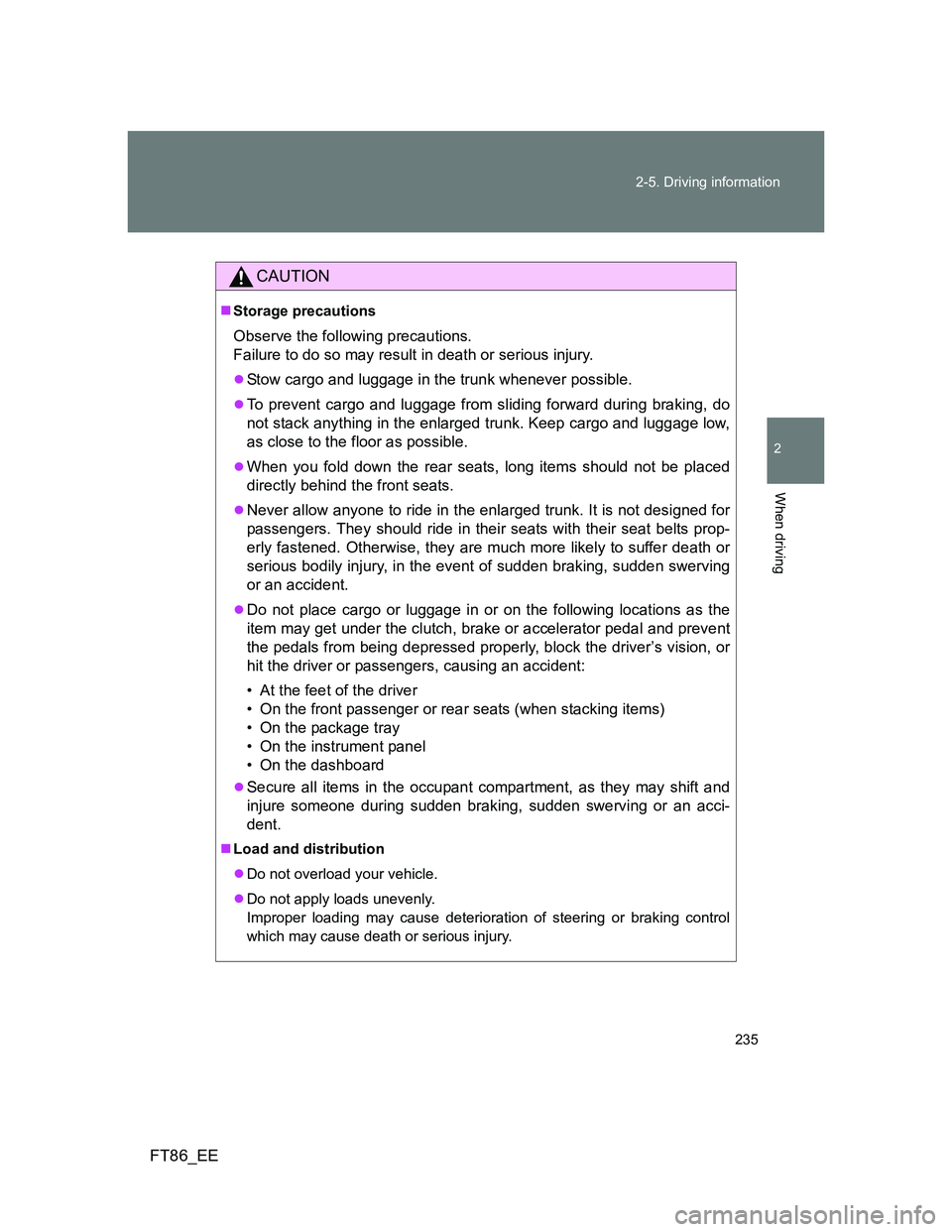Page 168 of 452

168 2-1. Driving procedures
FT86_EE
CAUTION
When braking
When the brakes are wet, drive more cautiously.
Braking distance increases when the brakes are wet, and this may cause
one side of the vehicle to brake differently than the other side. Also, the
parking brake may not securely hold the vehicle.
If the power brake assist function does not operate, do not follow other
vehicles closely and avoid hills or sharp turns that require braking.
In this case, braking is still possible, but the brake pedal should be
depressed more firmly than usual. Also, the braking distance will increase.
Have your brakes fixed immediately.
Do not pump the brake pedal if the engine stalls.
Each push on the brake pedal uses up the reserve for the power-assisted
brakes.
The brake system consists of 2 individual hydraulic systems; if one of the
systems fails, the other will still operate. In this case, the brake pedal
should be depressed more firmly than usual and the braking distance will
increase.
Have your brakes fixed immediately.
Page 176 of 452

176 2-1. Driving procedures
FT86_EE
Operation of the “ENGINE START STOP” switch
When operating the “ENGINE START STOP” switch, one short, firm press is
enough. If the switch is pressed improperly, the engine may not start or the
“ENGINE START STOP” switch mode may not change. It is not necessary to
press and hold the switch.
Electronic key battery depletion
P. 4 2
Conditions affecting operation
P. 3 8
Note for the entry function
P. 3 9
If the engine does not start
The engine immobilizer system may not have been deactivated. (P. 88)
Contact any authorized Toyota dealer or repairer, or another duly qualified
and equipped professional.
Steering lock
After turning the “ENGINE START STOP” switch off and opening and closing
the doors, the steering wheel will be locked due to the steering lock function.
Operating the “ENGINE START STOP” switch again automatically cancels
the steering lock.
Vehicles with an automatic transmission:
Check that the shift lever is securely set
in P. The engine may not start if the shift
lever is displaced out of P. The smart
entry & start system indicator light (green)
will flash quickly.
Page 195 of 452
195
2-1. Driving procedures
2
When driving
FT86_EE
Horn
After adjusting the steering wheel
Make sure that the steering wheel is securely locked.
The horn may not sound if the steering wheel is not securely locked.
(P. 76)
To sound the horn, press on or
close to the mark.
Page 202 of 452

202 2-2. Instrument cluster
FT86_EE
Indicators
The indicators inform the driver of the operating state of the
vehicle’s various systems.
Turn signal indicator
(P. 193)Shift position Indicator
(P. 191)
(Vehicles with a manual transmission)
Headlight high beam
indicator (P. 212)Shift-up indicator
(P. 191)
(Vehicles with a manual transmission)
(If equipped)
Front fog light indicator
(P. 218)Slip indicator
(P. 228)
Rear fog light indicator
(P. 218)“TRC OFF” indicator
(P. 229)
Security indicator
(P. 88)VSC off indicator
(P. 231)
(If equipped)
Smart entry & start sys-
tem indicator (P. 171)“VSC SPORT” indicator
(P. 229)
Shift position and shift
range indicator
(P. 184)
(If equipped)
REV indicator
(P. 162)
(Vehicles with an automatic transmission)
Upshift/downshift indi-
cator (P. 186, 188)
(If equipped)
Cruise control indicator
(P. 223)
(Vehicles with an automatic transmission)
“SPORT” indicator
(P. 185)
(If equipped)
“SET” indicator
(P. 223)
(Vehicles with an automatic transmission)
“SNOW” indicator
(P. 185)
(Vehicles with an automatic transmission)
*1, 2
*1
*1
*1
Page 218 of 452
218
2-3. Operating the lights and windshield wipers
FT86_EE
Fog light switch
: If equipped
The fog lights secure excellent visibility in difficult driving condi-
tions, such as in rain and fog.
Rear fog light switch
Turns the rear fog lights on.
Releasing the switch ring
returns it to .
Operating the switch ring again
turns the rear fog lights off.
Page 229 of 452

229 2-4. Using other driving systems
2
When driving
FT86_EE
Disabling the TRC system
If the vehicle gets stuck in mud, dirt or snow, the TRC system may
reduce power from the engine to the wheels. Pressing to turn
the system off may make it easier for you to rock the vehicle in order
to free it.
In this case, the brake LSD function remains on.
To turn the TRC system off,
quickly press and release the
button.
The “TRC OFF” indicator light will
come on.
Press the button again to turn the
system back on.
“VSC SPORT” mode
Your vehicle is equipped with two types of control modes to accom-
modate various driving preferences. The control modes can be
selected with the “VSC SPORT” mode switch. Normal mode allows
secure and smooth normal driving. When the switch is pressed, “VSC
SPORT” mode is activated. Control characteristics such as the VSC
and TRC are adjusted to afford maneuverability closer to what a
driver may have imagined, while a sense of security is retained.
“VSC SPORT” mode/Normal
mode
The “VSC SPORT” indicator and
VSC off indicator come on when
in “VSC SPORT” mode.
Page 234 of 452
234
FT86_EE
2-5. Driving information
Cargo and luggage
CAUTION
Things that must not be carried in the trunk
The following things may cause a fire if loaded in the trunk:
Receptacles containing gasoline
Aerosol cans
Take notice of the following information about storage precautions,
cargo capacity and load:
Stow cargo and luggage in the trunk whenever possible.
Be sure all items are secured in place.
To maintain vehicle balance while driving, position luggage
evenly within the luggage compartment.
For better fuel economy, do not carry unnecessary weight.
Page 235 of 452

235 2-5. Driving information
2
When driving
FT86_EE
CAUTION
Storage precautions
Observe the following precautions.
Failure to do so may result in death or serious injury.
Stow cargo and luggage in the trunk whenever possible.
To prevent cargo and luggage from sliding forward during braking, do
not stack anything in the enlarged trunk. Keep cargo and luggage low,
as close to the floor as possible.
When you fold down the rear seats, long items should not be placed
directly behind the front seats.
Never allow anyone to ride in the enlarged trunk. It is not designed for
passengers. They should ride in their seats with their seat belts prop-
erly fastened. Otherwise, they are much more likely to suffer death or
serious bodily injury, in the event of sudden braking, sudden swerving
or an accident.
Do not place cargo or luggage in or on the following locations as the
item may get under the clutch, brake or accelerator pedal and prevent
the pedals from being depressed properly, block the driver’s vision, or
hit the driver or passengers, causing an accident:
• At the feet of the driver
• On the front passenger or rear seats (when stacking items)
• On the package tray
• On the instrument panel
• On the dashboard
Secure all items in the occupant compartment, as they may shift and
injure someone during sudden braking, sudden swerving or an acci-
dent.
Load and distribution
Do not overload your vehicle.
Do not apply loads unevenly.
Improper loading may cause deterioration of steering or braking control
which may cause death or serious injury.